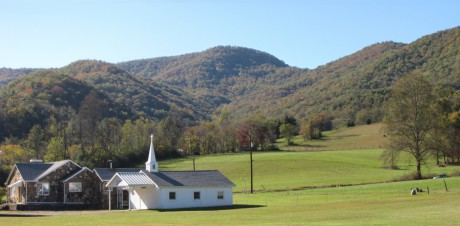Published in the Smoky Mountain News, February 25, 2015
Written by Becky Johnson
View the article on the Smoky Mountain News website.
As Paul Carlson tooled out of downtown Franklin, houses faded into rolling hayfields, and the Little Tennessee River soon took up its flank position along the edge of N.C. 28.
Carlson has driven the Little Tennessee Valley en route to his home in the rural Cowee community almost every day for 20 years.
But today, he was on a mission to lay bare the special ecology and human history of the Little Tennessee landscape, capped off with importance of protecting it, all in just two hours — a tall order given the 1,000 years of human history and couple hundred million in geological history he planned to plow through.
“It’s a poetic kind of statement, but you have this ancient landscape that didn’t get buried under a lake or buried under pavement,” Carlson said. “It is a righteous landscape. Within it, LTLT has made a difference.”
When Carlson founded the Land Trust for the Little Tennessee in 1997, a storm was brewing on the horizon, one that would unleash a torrential land rush over the coming decade. There wasn’t any time to waste.
“At the time there wasn’t a foot of river frontage in a conservation easement,” Carlson said.
Today, 36 miles of the river bank are protected, and a patchwork of conserved farms and forests are scattered across Macon County and beyond.
“See that spot there? That was going to be an RV park,” Carlson said, pointing to low-lying river bottom land.
It’s hard to see what isn’t there, but in a sense that’s LTLT’s legacy: what isn’t there, but what might have been.
Cresting over a small rise, Carlson slowed and leaned forward, craning a bit to get a better view out the top of the windshield.
A forester by trade, Carlson sees more than green mountainsides. Carlson sees both the forest and the trees simultaneously.
He pointed to the top of Cowee Mountain to the right, and Nantahala Mountain to the left — like bookends to the Little Tennessee River valley.
“This is the most intact forested elevational gradient in the southern Blue Ridge,” Carlson said. From one peak down into the river valley and back up to the opposite peak, dozens of micro-ecosystems inhabit their own stairstep of the mountainsides, uniquely evolved for that exact spot on the planet. It’s rare to have a top-to-bottom continuum that’s survived through the epochs.
“I won’t bore you with the numbers,” Carlson said, but convinced otherwise, he rattled them off. From the river valley at 1,700 feet, Cowee rises up to 5,000 feet on one side, and Nantahala rises to 4,700 feet on the other.
“You essentially don’t leave forested cover except to cross the river,” Carlson said.
The river itself is a last vestige of an intact aquatic ecosystem. It’s got more species diversity than any other river in the world that’s in a temperate climate.
“It is a remnant that hasn’t been dammed up or polluted out,” Carlson said.
“One of the early one-liners we had is acre-for-acre — how did it go? — something like, ‘Macon County has the richest combined natural and cultural heritage of anywhere in our country,’” said Carlson. “The job of a fundraiser is to come up with one-liners, but it is defensible.”
To Carlson, a trip down the Little Tennessee transcends time. It’s a journey through history and cultures.
“It is one of the greatest intact cultural landscapes in Western North Carolina,” Carlson said.
It’s not all idyllic though. It’s here where Cherokee were massacred and their villages burned. Where a rare African-American enclave in the mountains struggled to overcome the oppression and segregation of the early 1900s.
But Carlson also has long view of human occupation of the Little Tennessee River Valley. All of it’s prefaced with little-known honor as a critical outpost of the Western frontier.
Getting through the mountains was a formidable challenge, not only for settlers but for native people.
Long before white people arrived on American soil, tribes traded and traveled across vast networks reaching from the Atlantic Ocean to the Mississippi and down to the Gulf.
Rivers were the best mode of long-distance travel, and with a little weaving and jogging, rivers pass through the Southern Appalachians.
The only real dilemma was getting up and over the eastern continental divide.
Carlson rifled through a stack of maps on the console beside him, and then on the dash, and made a furtive stab at the back seat. There were a lot of maps here, but not the one he was thinking of.
“Oh well, I’ll just draw it,” Carlson said.
He flipped over a piece of white scrap paper to the blank side and began scribbling out a map of the mountain ranges that mark the eastern continental divide, starting with Mount Rogers in Virginia, and coming south.
Next he penciled in a series of passes over the eastern continental divide, and the major river valleys on each side. The lowest, most gentle way over the divide was at the southern end of Macon County, he said.
“You can cross the eastern continental divide without even realizing it,” Carlson said.
Once across, the Little Tennessee River Valley was a clear shot to the Tennessee River and onward to the Mississippi.
When Europeans arrived in America, the Little Tennessee River Valley was the gateway to the country’s interior, the westernmost trading post.
“This was a very cosmopolitan place back then — the geopolitical center of the South,” Carlson said.
The chief export from America’s Southern interior was deerskins. Canoes of deerskins traveled the Little Tennessee en route to the docks of Charleston and then onward to England, where they were in high demand for everything from book bindings to gloves for foundry workers in the burgeoning industrial revolution.
But the strategic station of the Little Tennessee also made it a prime target in the coming wars.
The Cherokee were caught in the middle as wars played out for control of their trading stronghold — a coincidence of geography that ultimately led to their demise.
“It was where the British Empire and French interests end up colliding with native peoples,” Carlson said. “And it was the first campaign of the American Revolution in the South.”
That campaign is the darkest hour of the Little Tennessee Valley. Fearing the Cherokee would side with the British, colonial militia — 4,000 in all from four legions — converged on the Cherokee towns that lined the Little Tennessee, leaving nothing but pillaged ruins behind.
But after 200 years of white ownership, Cowee Mound in Franklin now belongs to the Cherokee people again, thanks in part to the work of the land negotiations and maneuvering by LTLT.
LTLT amassed four separate tracts protecting the mound.
One critical piece of the puzzle was a 108 acre tract overlooking the mound, known as the Hall Mountain tract. Developers from California bought it during the real estate boom and began carving it up into lots, but were halted by the recession.
“They lost it back to the bank, and then LTLT was able to step in and acquire it very affordably,” Carlson said.
Ultimately, the Eastern Band of Cherokee Indians bought the tract from the LTLT, but the opportunity would have been lost had it not been for LTLT’s role as a stopgap.
Carlson eventually left the gentle farm and along the river behind, redirecting the tour to the modern story of the Needmore tract.
Saving the Needmore remains the crowne jewel of LTLT’s work — at least in terms of tangible impact.
LTLT was a critical player in the campaign to rescue the 5,000-acre tract, on both the political lobbying and fundraising sides. But the heaviest lifting was bringing public support for the tract’s conservation into a cohesive voice.
When Needmore came along in 1999, it catapulted LTLT from a scrappy upstart nonprofit to a major force and a household name regionally.
“We suddenly had a real big project. We started to get some national focus and attention,” Carlson said.
The Needmore was also a litmus test for the new paradigm in conservation Carlson and others were pushing at the time: one that included the human heritage of the land as well as the environmental.
This meant not only preserving the Needmore as hunting and fishing grounds, but farming as well.
“Part of the political strength and political story was to keep the farm land available for leasing. That helps a lot of support be realized,” Carlson said.
It’s hard for Carlson to discuss his life’s work without getting wistful.
“This was a great place to raise a kid,” Carlson said. “When (my daughter) was 5, 6, 7 years old, we’d come down here with a little picnic and wade out on the rocks and take a look around under the water with a snorkel mask.”
Perhaps it’s part of Carlson’s motivation for LTLT, a vehicle to protect the river valley for future generations. Western North Carolina certainly isn’t shy on protected land, but here in the far-flung corner of the mountains, only the high-elevation uplands, the rugged ridges and steep mountainsides are graced with national forest.
“The mountains are righteous, but the valley was important,” Carlson said. “That was the fundamental decision early on, to decide we were going to focus on the valley.”



